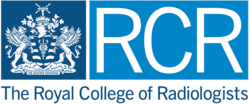Royal College of Radiologists
The Royal College of Radiologists (RCR) is the professional body responsible for the specialty of clinical oncology and clinical radiology throughout the United Kingdom. Its role is to advance the science and practice of radiology and oncology, further public education and set appropriate professional standards of practice. The College also sets and monitors the educational curriculum for those training to enter the profession. It is a registered charity in the United Kingdom (no. 211540).[1]
 | |
| Motto | Ex Radiis Salutas (Latin for "From Rays, Health") |
|---|---|
| Formation | Association: 1934 Faculty: 1939 College: 1975 |
| Type | Medical royal college |
| Headquarters | Lincoln's Inn Fields, London, England |
Region | United Kingdom |
| Publication | Clinical Radiology Clinical Oncology |
| Affiliations | Academy of Medical Royal Colleges |
| Website | www |
The College publishes two journals, Clinical Oncology and the Clinical Radiology Journal, as well as awarding various prizes and scholarships.
History
A series of bodies has represented practitioners of radiological medicine in the UK, starting in 1897 with the foundation of the Roentgen Society (named for the physicist Wilhelm Conrad Röntgen). Subsequently-founded societies included the British Association of Radiologists (1934), the Society of Radiotherapists of Great Britain and Northern Ireland (1935) and the Faculty of Radiologists (1939).
In 1950 the first issue of the Clinical Radiology Journal was published by the Faculty of Radiologists, who were then granted a Royal Charter of incorporation in 1953. Professor Sir Brian Windeyer helped found and became President of the Faculty of Radiologists from 1949-52.[2] A supplemental charter was given in 1975 to rename the Faculty as The Royal College of Radiologists. The College then published the first issue of Clinical Oncology in September 1989.
Fellowship of Royal College of Radiologist Examinations
Candidates are examined against the Specialty Training Curriculum for Clinical Radiology. The specialty trainees are expected to complete their First FRCR examination before progressing to ST2. During their ST3 training year they are expected to pass the Final FRCR Part A examination, and must complete this before progressing to ST4. During ST4, trainees are expected to pass the Final FRCR Part B examination.[3]
First FRCR examination
The fellowship examinations start at the beginning of the Specialty Training Year 1 (ST1). The First FRCR examination expects candidates to have gained a knowledge of the physical principles that underpin diagnostic medical imaging and of the anatomy needed to perform and interpret radiological studies.[4][5] The First FRCR examination comprises two modules: Physics and Anatomy. The anatomy modules is a 90-minute exam comprising 100 images, where each image has several annotations, each of which in turn has a single related question.[6] The physics module is a 120-minute multiple choice question paper comprising 40 questions, each with five true or false answers.[6]
Final FRCR Part A examination
The Final FRCR Part A examination comprises single best answers, split into two separate papers for the purposes of delivery. Each paper contains 120 questions and examining candidates on all aspects of clinical radiology and the basic sciences of physics, anatomy and techniques.[7]
The main areas examined are:
1. Cardiothoracic and Vascular
2. Musculoskeletal and Trauma
3. Gastro-intestinal
4. Genito-urinary, Adrenal, Obstetrics & Gynaecology and Breast
5. Paediatric
6. Central Nervous and Head & Neck
Final FRCR Part B examination
During the ST4 training, the specialty trainees are expected to complete the Final FRCR Part B. The Final FRCR (Part B) examination consists of a reporting session, a rapid reporting session and an oral examination.[8]
The extensive examination provided by the RCR ensures a high quality and standard of radiology consultants. It has been deemed as one of the hardest examinations in the medical profession, along with the FRCA and FRCPath.
List of Fellows
- Moya Cole
- Dr. K.A. Dinshaw
- Adrian Dixon
- Frank Ellis
- Janet Husband
- M. Krishnan Nair
- James Ralston Kennedy Paterson
- Kakarla Subba Rao
- Robert Twycross
- Joanna Wardlaw
- Syed Junaid
- Brian Hayes
- Pankaj Nagori
See also
- Society and College of Radiographers
References
- Wales, The Charity Commission for England and. "About Charities". www.charity-commission.gov.uk.
- Windeyer - history of a building, accessed 23 March 2013
- "Clinical Radiology Curriculum". Royal College of Radiologists. Retrieved 12 March 2019.
- "Final FRCR Part A Examination | The Royal College Of Radiologists". www.rcr.ac.uk. Retrieved 28 August 2016.
- "First FRCR exam". Radiology Cafe. Retrieved 12 March 2019.
- "First Examination for the Fellowship in Clinical Radiology - Guidance Notes for Candidates" (PDF). Royal College of Radiologists.
- "Final Examination for the Fellowship in Clinical Radiology (Part A) Single Format - Guidance Notes for Candidates" (PDF). Royal College of Radiologists.
- "Final FRCR Part B Examination | The Royal College Of Radiologists". www.rcr.ac.uk. Retrieved 28 August 2016.